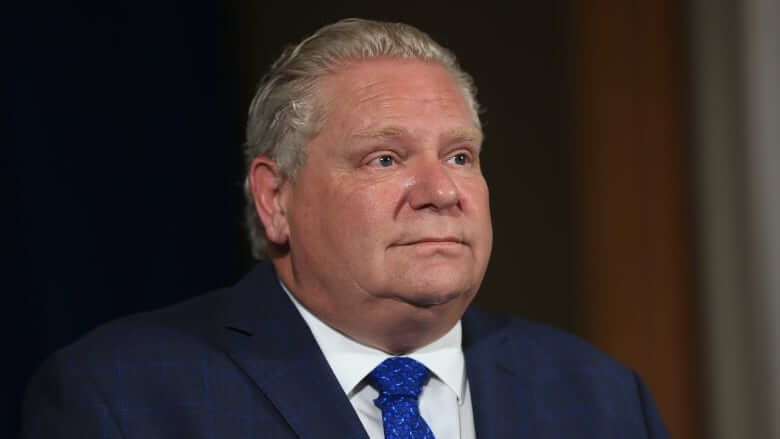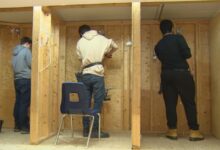Ontario to begin easing COVID-19 restrictions on Jan. 31, with plan to lift most measures by mid-March

Ontario will begin easing COVID-19 public health restrictions at the end of January, the government said Thursday, with a plan to lift most remaining measures by mid-March.
Starting Jan. 31, a host of indoor settings will be able to reopen to the public with 50 per cent capacity limits, including:
- Restaurants, bars and other food establishments without dancing.
- Retailers, including shopping malls.
- Gyms and non-spectator areas of sports facilities.
- Movie theatres.
- Meeting and event spaces.
- Museums, galleries, aquariums, zoos and similar attractions.
- Casinos, bingo halls and other gaming establishments.
- Religious services, rites and ceremonies.
Spectator areas of things like arenas and concert venues will also be open at 50 per cent capacity or up to 500 people, whichever is less, the government said in a news release.
Enhanced proof of vaccination and masking requirements will remain in place.
Moreover, indoor social gatherings of up to 10 people and outdoors gatherings of up to 25 will be permitted.
Then on Feb. 21, social gathering limits will increase to 25 for indoors and 100 people outdoors. Other planned changes include:
- Removing capacity on all indoor spaces where proof of vaccination is required.
- Allowing spectator capacity of up to 50 per cent at sports, concert and other similar venues.
- Limiting capacity in most other indoor spaces where proof of vaccination is not required to the number of people who can maintain a physical distance of two metres.
- Increasing indoor capacity limits to 25 per cent for remaining “high-risk settings” where proof of vaccination is required, such as nightclubs, wedding receptions in event spaces with dancing, as well as bathhouses and sex clubs.
Finally on March 14, according to the government, all capacity limits on indoor spaces will be lifted. Proof of vaccination and masking requirements will continue to remain in place where they already exist.
All capacity limits will also be lifted for religious services, rites and ceremonies, and social gatherings of up to 50 people indoors will be permitted, with no limit for outdoors.
Ontario Premier Doug Ford announced the planned changes at a morning news conference Thursday. He was joined by Health Minister Christine Elliott and Dr. Kieran Moore, Ontario’s chief medical officer of health.
Ford stressed that the timeline could change based on current COVID-19 trends and data in the province.
“We’re taking a cautious approach,” Ford said, before adding he’s “confident” this reopening plan will work and that “the worst is behind us” in terms of new COVID-19 cases.
This week, Elliott said Ontario is starting to see “glimmers of hope” in trends related to Omicron, with new cases expected to peak at some point in the coming weeks. It is anticipated that hospitalizations, which now stand at more than 4,000, will begin to taper off in the weeks after that, likely at some point in mid-February.
The rate of new admissions to hospital and ICUs has begun to slow, she said, while the average length of stays for those who are admitted is stabilizing.
The government’s announcement today did not include any mention of Directive #2, which earlier this month ordered hospitals to halt non-urgent surgeries and procedures. Elliott said it would remain in place until ICUs begin to clear of COVID-19 patients.
There was similarly no mention of expanding PCR testing criteria, which was significantly restricted in early January to only the most high-risk individuals and settings as the system dealt with a deluge of new cases caused by the Omicron variant.
Lowest test positivity rate in nearly a month
Meanwhile, Ontario reported Thursday morning that the number of people with COVID-19 in hospital dropped for a second straight day to 4,061 from 4,132.
The Ministry of Health says that 55.1 per cent of those patients are in hospital because of COVID, while 44.9 per cent were admitted for other reasons and tested positive — although doctors say so-called “incidental” cases continue to place immense strain on the system.
As of Wednesday evening, there were 594 people with COVID-19 being treated in intensive care, the most since early June. Of those patients, 81.1 per cent were admitted to ICU because of the illness while 18.9 per cent were already in critical care when they were diagnosed.
Furthermore, Public Health Ontario logged a 15.9 per cent positivity rate on 42,907 test samples. It is the lowest rate recorded in Ontario since Dec. 21. Moore said Wednesday that positivity rates appear to be flattening between 20 and 25 per cent, after climbing into the high 30s earlier this month.
The Health Ministry also reported another 75 deaths of Ontarians with COVID-19, which apparently occurred over the last 19 days. A ministry spokesperson said the additional deaths were included in the update after ongoing data cleanup efforts.








Redes Sociais - Comentários